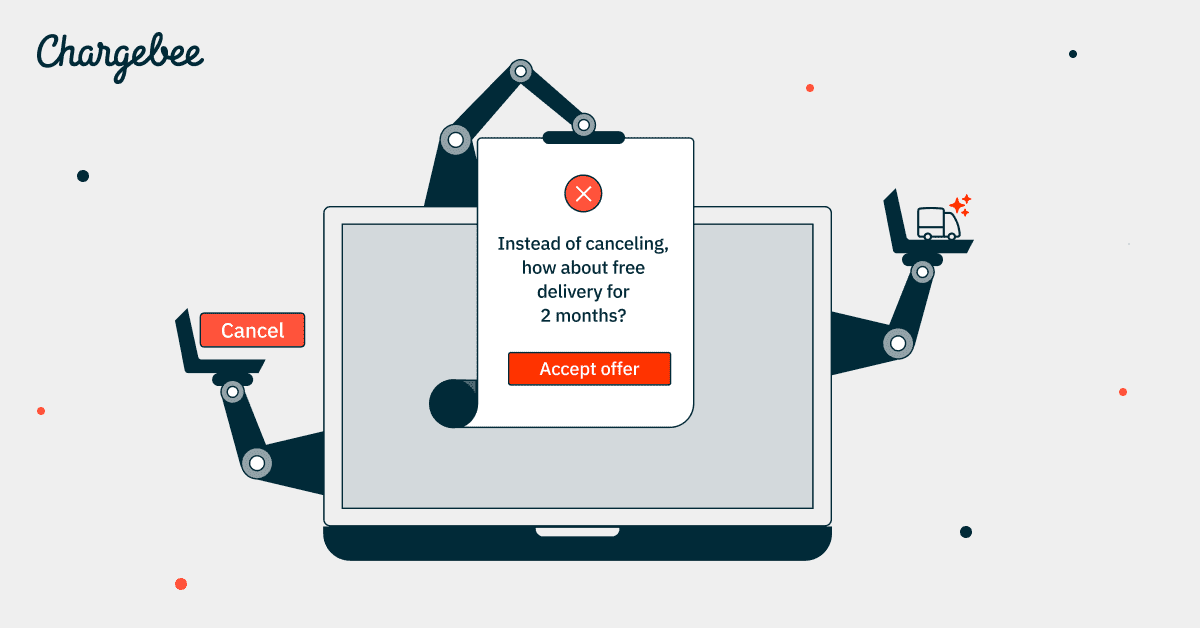The late-2022 SaaS multiple compression is symptomatic of a mindset shift in the industry – that stability is, for now, more important than growth. Investors value companies based on net-dollar retention (NDR) and the Rule of 40, as rising interest rates and shrinking purchasing power put net-new sales under pressure. Moreover, new regulations from California and New York regulations mandate easy customer access to the cancel button. If there ever was a lifeboat, it is now floating further away.
Retaining your customers at all costs is sadly not the solution to the problem. According to a Chargebee Retention survey, making cancellation flows more difficult never helped businesses retain better in the first place. The survey says that 80% of consumers would be less likely to repurchase from a company after a problematic cancellation experience.
What does this say about staying true to building retention-worthy cancellation experiences? At cancellation, your customers need to feel less ‘imprisoned’ and more ‘enabled.’
Having been at the heart of subscriber and retention experiences of 4500+ businesses, we know first-hand what a true automation-led enablement looks like, especially at a juncture as sensitive as a cancellation. Let’s dive into the details of how you can also reimagine exit points into influence points and use automation to create a churn-arresting cancellation flow.
What does automating your cancellation experience mean?
Automation has represented a tectonic shift for businesses; it is what most SaaS businesses base themselves on – fulfilling the promise of higher efficiency, consistent quality, and lower operating costs. Applying it to the cancellation process means creating a cancellation flow, a sequence of steps rolled out without additional tech/dev-dependency, from when the user hits the ‘Cancel/Unsubscribe’ button to when they’ve officially churned.
We say – ’till the point they’ve churned’ since it is essential to recognize that some customers might outgrow or find diminishing value in your product. In this case, offloading can happen in-app or via a self-service portal and can still be set up to be engaging, on-brand, and seamless enough for them to stay active advocates of your solution to their peer groups.
An effective cancellation flow keeps customers from exiting, minus the friction that prevents them from canceling painlessly. It has the following implications for customer success and product managers:
Guides product success
Product success dictates business success. Product managers have a unique role to play in driving revenue and profitability. In that role, improving the product with a correct understanding of customers’ needs and experiences is pivotal.
An engaging cancellation experience considers the importance of collecting active customer feedback and informing relevant teams about core issues by integrating them into their existing tools. It automatically identifies features in the product roadmap that need to be prioritized without the product manager intervening to seek manual customer feedback.
Sometimes, a deal-breaking product/feature issue comes to light when you know it from the horse’s mouth. This issue is far more common among startups than you’d like to believe.
“Frequently, the product we end up with differs from what we started to build. Our email system seems more like a group chat; our database seems more like an analytics platform, and our cake has become muffins.
This transformation happens so gradually that we, the product creators, often don’t notice it. We still see the product as the thing we set out to build.”
– April Dunford, Obviously Awesome
Human mobility platform, pliability initially had an NPS-based feedback mapping on their cancel page. While it did help them get accurate feelers on crucial problems, it didn’t consider that the customer’s perspective of the product could be completely different from the product manager’s.
With Chargebee Retention, they went beyond just NPS to enable long-form customer feedback collection. They found some experiential issues (some accounted for, others unexpected) for the product team to prioritize. It helped them transform retention into a growth lever and iron out issues for future customers!
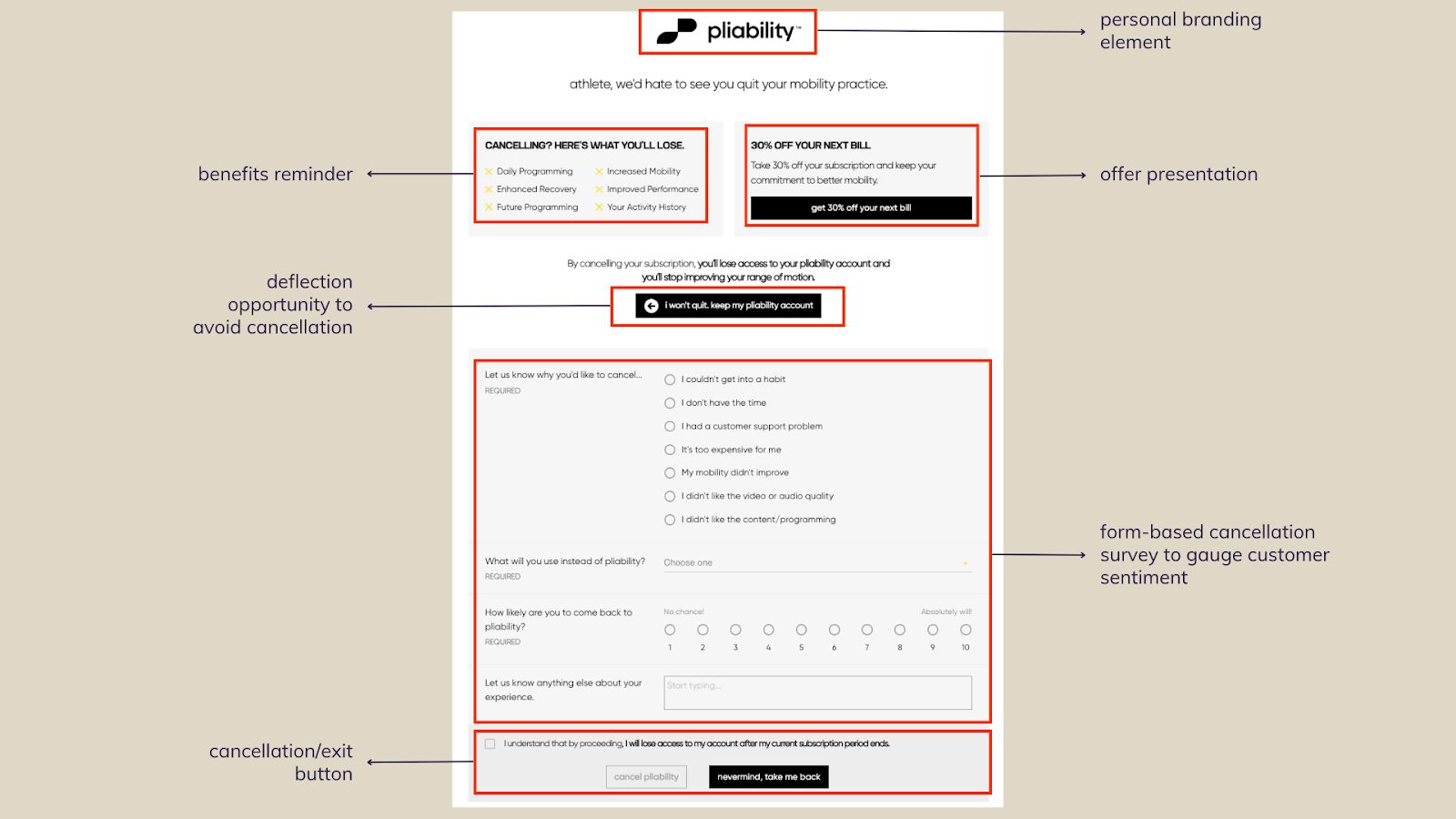
Accurately tagging cancellation reasons can prevent churn and make your product more customer oriented.
Supercharges retention strategies
Alongside account expansion and upselling, lowering churn is a crucial goal for customer success managers. Between onboarding and converting ‘free trial’ to ‘paid’ customers to providing efficient front-line support as needed and stemming churn, CSMs have a lot on their plates.
A detailed summary of retention performance, including crucial churn metrics, can help them focus on building retention strategies without starting from scratch. At the same time, it offers structural feedback on what is working (or isn’t), so making a retention strategy is a process, not a reinvention.
Furthermore, it is also about understanding who to retain. If you spend the same effort retaining a low-ticket customer as a high-ticket customer, your customer-success or retention-focused team should be more judicious.
Chargebee Retention simplifies customer prioritization by automatically segmenting the high-value from the fractional customer to help determine who you should offer your most attractive discounts/offer buckets.
Creates a consistent brand experience
Customers expect businesses to be as invested in them post-sale as before the acquisition. A company that makes returns or refunds difficult will only have disgruntled customers, no matter how smooth their acquisition flow is.
For SaaS subscription businesses, customer experience (CX) management is sacrosanct and supported in no small way by cancellation flows. Automation inherently standardizes and streamlines these processes.
In Chargebee’s case, the tool first understands churn intent through the customer feedback stage and then delivers offer personalization closer to the customer’s highlighted issue.
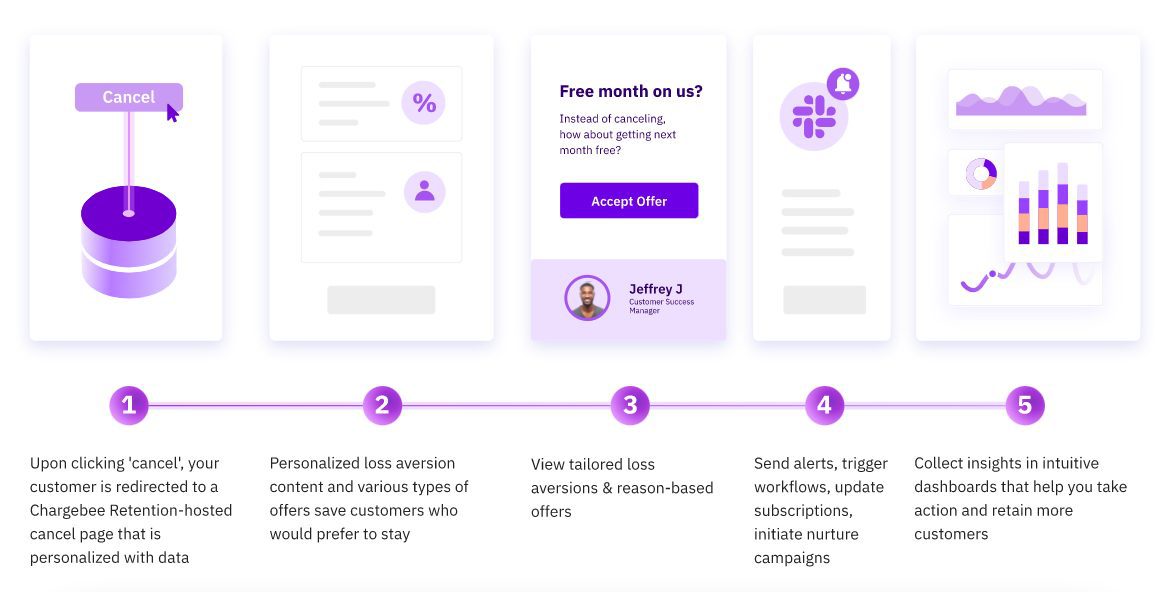
It means if a subscriber wants to discontinue because of a high price point, you can offer them a downgrade, or if a customer is looking to cancel since they don’t have an immediate use for your product/service, they could be referred to a pause, instead then having them leave your business.
On the surface, providing a consistent cancellation experience can be seen as table stakes, but it can become a differentiator over time.
What the best cancellation flows get right
A cancellation flow aims to understand why customers are leaving, which is crucial to improve retention and offer alternatives that trigger a change of heart. In practice, this would mean presenting users with a simple survey asking them to state their reasons for leaving and personalized offers that convince them to stay. Yet, that’s not all.
Customers may churn for reasons other than dissatisfaction with your product or inability to derive value from it. Squeezed by budget cuts, they may be forced to trade down or let go of some subscriptions (usually, the ‘nice to haves’ or discretionary products are the first on the chopping block). The downgrades and scalebacks could also be temporary; reverting to previously used products or plans is possible as the business environment picks up. For this cohort, the cancellation flow should include the option to pause their subscription. It gives recurring revenue a fair shot of bouncing back.
With this overview, let’s understand how automation would transform the cancellation flow:
1. It collects information about customers who churn and uses that data to fuel win-back campaigns at a later date
A customer exit survey can reveal the silent reasons for churn and prevent it from becoming uncontrollable after a point. For example, if customers leave, irked by a product bug, you can safely assume that other users will follow suit. The product team will have to spring to action sooner rather than later.
There’s no looking back for customers who’re unhappy using your product. But they did choose it after believing it would solve some business problem or offer some business benefit. A better product value proposition (at a competitive price) can encourage a repurchase. Your retargeting efforts should have the right messaging based on the specific churn reason, which is easier to identify with exit survey data collected at cancellation.
Static customer surveys don’t go the whole hog. As market sentiments evolve, so should the choice of exit survey responses. A dynamic customer exit survey is more easily implementable with Chargebee Retention, aggregating survey data into easy-to-ready reports encapsulating customer feedback on missing features, pricing, reliability, and overall product satisfaction.
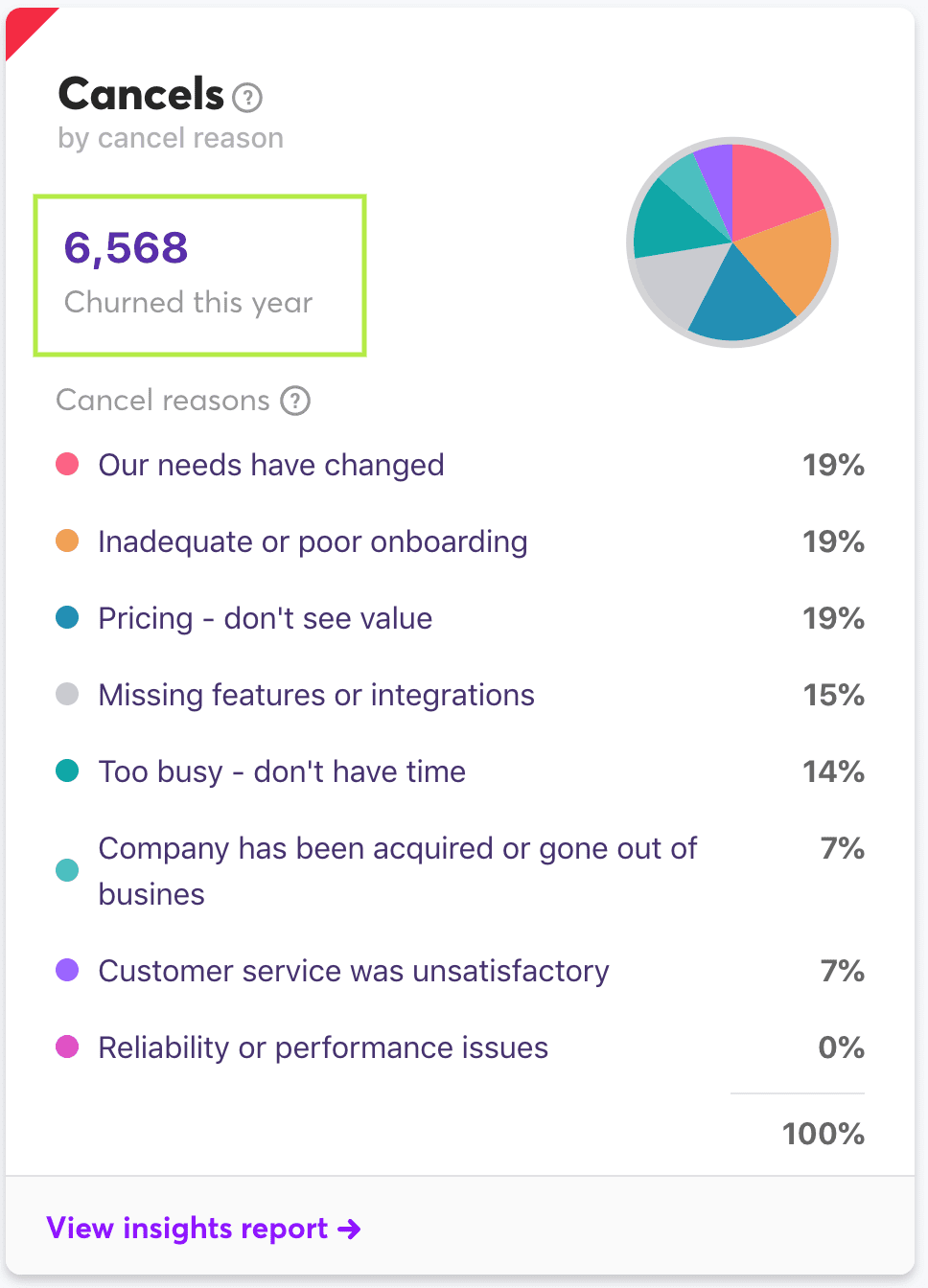
2. It provides contextualized offers
Presenting personalized offers to customers intending to churn can work like a charm. For best results, it must be done strategically.
For businesses, offering a free extension to every customer (even a recently acquired account) is a heavy drain on their bottom line without guaranteeing success. Hence, creating offers based on account attributes, customer journey stage, and exit survey results are more effective in deflecting cancellations.
Personalized offers in the online cancel flow help optimize cancels and revenue
A traditional cancellation process cannot personalize offers for customers with cancel intent. It relies on internal teams to modify customer exit surveys and has no means of continuously collecting data on how retention offers to perform for different customer segments.
Automation allows you to create hyper-personalized offers triggered at crucial moments in the cancellation flow. Vital Proteins set up targeted multivariate testing for reference to present distinct offers for their long-term and new subscribers. The result – fully optimized discount offered doubled save rates for the business.
Types of save offers
Discounts
The offer to slash prices works well for customers who derive value from your product but cite high costs. It’s unlikely to appeal to customers who have yet to see any value in your product but are asked to continue for less money.
Pause
Enabling a pause is a winning retention tactic. The option to pause a subscription rather than an outright cancellation is part of an effective retention improvement game plan that the digital gift-card business, Touchnote, executed perfectly. Their “one-month pause” offer at cancellation generated a 100% conversion rate, keeping customers glued to their business.
Support and training
Depending on product complexity, the offer to train users on its effective implementation may or may not be an option; however, since no one knows the value of your product better than you, sharing your insights with users so that they can maximize its benefits is worth a shot. It is also a low-cost offer, involving only an investment of your time for training sessions and consultations with agents.
You can also direct your efforts to create resources for a specific customer cohort. For example, you can share your latest features and extensions with your long-term customers to shape a different perspective of your product in their minds.
Plan changes
Customers may cancel because their plan no longer works for them or wasn’t the right one. Presenting them with offers to upgrade, downgrade, change plan terms, or switch bundles can be effective. Of course, you’ll have to determine the ideal user plans based on the customer journey and a broader understanding of their profiles and needs.
It is easier with Chargebee Retention as it offers strategies to test offers and identify the right combination of offers.
Repeatability creates more time for improving the master retention plan
Automation saves customer success teams hours a week for analysis and planning. Once offers are automated, they ensure repeatable targeting, leaving customer success teams free to analyze retention performance and drive growth armed with the supporting data.
For example, knowing which customers contribute the most revenue helps prioritize retention and upselling those accounts. The data can also help inform the development of future product strategies.
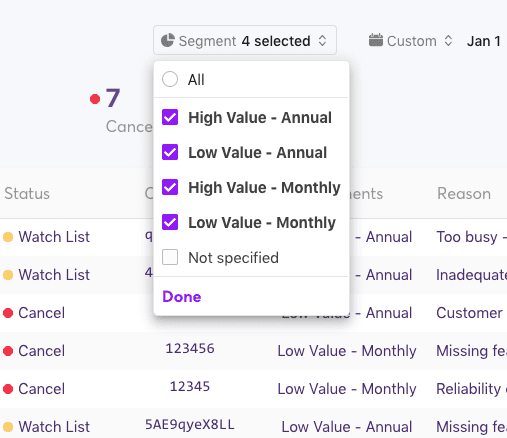
3. It averts crisis and sounds a rallying call to act NOW
Your cancellation flow can stop a customer from leaving. But the customer is still a churn risk because the triggering issue also needs quick redressal. Fortunately, this isn’t something a robust cancellation flow cannot handle.
With the understanding that saved users must stick on, the flow incorporates an instant engagement component that allows customers to get back on track.
Here’s how it looks when you’re using Chargebee Retention – when a customer cancels anyway, the platform triggers an alert, which includes the reason for canceling, and shares it with your customer success managers. Collecting and feeding cancellation reasons to customer success teams allows them to engage better with the customer in a productive conversation at a critical moment.
If it goes well, you’ve saved a customer. If it doesn’t, you still have the information to retarget the customer through a win-back campaign or determine whether or not you should go after them. It is, perhaps, the most significant advantage of an automated workflow – the ability to reach out to a customer right when they have their hands raised.
You’ll likely be cold-shouldered if you let them leave silently and initiate a conversation later. The customer may be signing up for a different product. The bottom line: winning back a former customer (even if it’s been only 48 hours since they canceled) is an uphill task. The sooner you reach out, the better your chances of retaining the customer or getting their permission to connect shortly.
Landing page and conversion intelligence platform Unbounce used Chargebee Retention with Zapier and Salesforce to trigger an alert in a dedicated Slack channel of support and success managers whenever a customer canceled due to billing issues. With the reason for cancellation handy, customer-facing teams were better equipped to triage and engage with customers, helping them deflect 11% of all cancellations.
Make revenue growth smarter with Chargebee’s automated cancellation experiences
The actual test of your retention strategy is what happens to it when customer loyalty finds enough reasons to flounder. Today’s economic climate is a reason and a half. Yet, with smart technology and an arsenal of capabilities, businesses can build cancellation flows that extend a helping hand to customers during challenging times.
More and more SaaS businesses are increasingly choosing automation for their cancellation flows to help them build personalization at scale, drive meaningful experiences and arrest current (and future) churn without spending additional resources on the problem.
As the focus shifts to NDR and bottom-line growth, retention discipline will define which businesses can use this opportunity to build better margins, turn towards profitability and gain long-term competitive advantages when the (economic) storm has passed.
Find long-term durability and convert exits to influence, without moving a muscle. See how Chargebee can help automate your cancellation process today.
